What do pink, orange, and the alphabet have in common?
Answer: They’ve changed.
All three of these are examples of language changes in recent years, at least in Spanish. Thus, they’re the three biggest changes we made in our recent rather significant update to Calico Spanish Classic for Schools, our beginner level for elementary Spanish teachers (now retired from print but still available on TeachersPayTeachers).
– Follow us on Twitter –
Alphabet changes
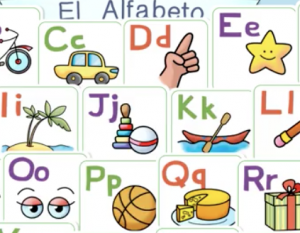 In 2010, the RAE made some changes to the alphabet. This concept is a bit foreign, to be punny, to English speakers, because we don’t have an academic body that meets to decide what is English and what is not, or whether it’s time for the alphabet to change. But Spanish does. And in 2010, the Real Academia Española decided to make the following changes to the official Spanish alphabet:
In 2010, the RAE made some changes to the alphabet. This concept is a bit foreign, to be punny, to English speakers, because we don’t have an academic body that meets to decide what is English and what is not, or whether it’s time for the alphabet to change. But Spanish does. And in 2010, the Real Academia Española decided to make the following changes to the official Spanish alphabet:
- The letters ch and ll were removed, because they are digraphs (a pair of letters that represent a single sound, like th and ph in English). Rr, also a digraph, was never part of the alphabet, though interestingly, it apparently used to be taught as a letter of the alphabet in Argentina.
- The new name of “y” is ye.
- The only name for “b” is be.
- The only name for “v” is uve.
- The only name for “w” is uve doble.
– Like Calico Spanish on Facebook –
Color changes
What about pink and orange? This isn’t an issue of the RAE, really, but rather how people talk. As Spanish teachers, we often learned vocabulary from textbooks that told us the word for pink is rosado and the word for orange is anaranjado. As I collected children’s books for my children, though, I started to notice some of them used rosa and naranja for these colors. Had the word changed? What did users actually use?
As we continue to develop Calico Spanish Stories Level D (“I Like the Farm”), which features a new pig character as well as a mother-daughter Monarch butterfly team, our color focus is pink and orange. So, it was time to investigate exactly which words to use. Wow, has this usage changed. I was so surprised.
Songs and children’s books are all over the map on this, including our own popular “Colores, colores,” which uses anaranjado (but does not include pink). The WordReference forums muddy the waters even more, giving the “old” usage of rosa as the color as a noun, and rosado is the adjective, varying from country to country.
So, I went to my source of all things frequency related: I hit Google.
– Follow us on Instagram too! –
Pink
Here’s what I found on pink:
- vestido de color rosa: 735,000
- vestido rosa: 408,000
- vestido rosado: 350,000
That’s right. The usage we all learned in school, vestido rosado, is actually the least common. In fact, the Spanish online shopping site Zalando offers vestido rosa and vestido de color rosa but not vestido rosado at all.
But this isn’t even consistent across nouns, not even across masculine nouns. See what happened when I changed it to “pig”:
- cerdo rosado: 90,000
- cerdo rosa: 40,000
- cerdo de color rosa: 28,000
Orange
Now, what about orange? Here’s what happened with mariposa:
- mariposa naranja: 35,000
- mariposa de color naranja: 32,000
- mariposa anaranjada: >20,000
Again, the phrase I would’ve used based on what I learned in school is least common.
With gorra the phrase gorra de color naranja comes out on top by a significant margin. Here’s how significant that margin is with vestido:
- vestido de color naranja: 600,000
- vestido naranja: 300,000
- vestido anaranjado: 17,000
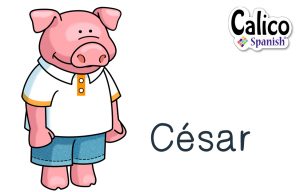 It seems like rosado has always really meant “pinkish” and anaranjado has always meant “orangeish,” and now usage is really reflecting that.
It seems like rosado has always really meant “pinkish” and anaranjado has always meant “orangeish,” and now usage is really reflecting that.
In case you’re curious about what we decided to do with these colors in Level D:
César es un cerdo rosado.
Ofelia tiene una gorra rosa.
Mía es una mariposa negra y naranja.
César tiene una bufanda de color naranja.
Introduce a child you love to a lifelong journey of speaking real Spanish to real people. Click the red button to experience it FREE.
Our updates
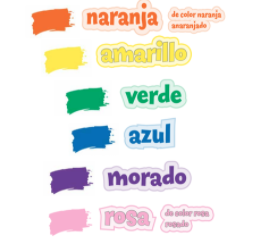 Curious as to how these changes play out in our digital download of Classic?
Curious as to how these changes play out in our digital download of Classic?
We want to be up-to-date on language usage!
- Before: Each chapter introduced one letter of the traditional alphabet, including ch and ll. Because there were only 15 chapters, this meant only A-M were included in the curriculum chapters. Lessons for N-Z were added in an appendix.
Now: Each chapter includes lessons for 1 or 2 letters of the current, 2010 RAE alphabet, and lessons for all letters appear within the chapters and their scope and sequence plans. Optional lessons for ch and ll are in an appendix. - Before: flash cards, posters, and lesson plans referred to pink as rosado and orange as anaranjado with outdated language notes for anaranjado.
Now: Flash cards, posters, and lesson plans give preference to rosa, de color rosa, naranja, and de color naranja with language notes on how these uses have changed and the current usage of rosado and anaranjado.
And guess what? We’ve even updated our alphabet song to reflect the 2010 alphabet. (That release will be announced in a separate post.)
We want to provide you with the very best in elementary Spanish curriculum options, and when we see a significant language change, we see an opportunity to improve. We hope you’ll agree.





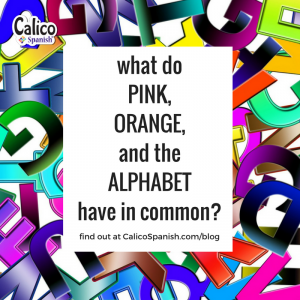
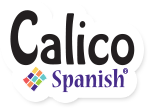
7 Comments
Thank you for this clarification and update!
Thanks for this useful information. I do wonder when you use as basis children’s books, where were those books published? by whom? who were the authors? translators?
It does worry me that frequency of usage be established based on books that have been written/translated by people whose primary language is not Spanish. These books may be influencing the language use.
“de color rosa” sounds to me as a transliteration from English,
and “rosa” as a substitution of “rosado” unnecessary empobrecimiento of the language
Hola Alma, what an honor for you to stop by. It’s a good question. To clarify, my frequency numbers here don’t come from published books, but from usage on the internet. As far as numbers go, of course I can’t tell Google what type of sites to ignore or not to ignore, but I did navigate through many of the top hits, looking for what authentic websites were using. So, for example, I ignored posts on Word Reference or language learning sites, and instead went to clothing shopping sites in Spanish-language countries, blog posts on fashion and design by native Spanish speakers, etc. An example would be this phrase from a European automobile club in Madrid (www.cea-online.es): “…se recomendaba a los automovilistas que llevasen una indumentaria con colores llamativos para bajarse del vehículo, tales como el amarillo, el naranja o los colores fosforescentes como el verde.”
I feel your frustration on rosado– so many language changes I would characterize as unnecessary empobrecimiento. Good phrase for it.
Hola!
Realmente no veo problema alguno al usar color rosado o rosa. Personalmente uso siempre rosado. Toda mi vida (soy nativa) lo he hecho y seguiré en lo mismo. En cuanto a la Y, en el cole me enseñaron a decir Ye o ygriega las dos alternativas son válidas.
Saludos
Gracias por la respuesta, Nelly. Parece que los hispanohablantes nativos usan “rosado” “de color rosa” y “rosa” sin distinguir mucho entre los tres, y por eso actualizamos el program para incluir los tres. ¡Esperamos que sirva de ayuda en mostrar lo variado que es el idioma español!
Was RR ever part of the Spanish alphabet?
Hi Michael! The digraph rr was never part of the Spanish alphabet, according to Wikipedia, probably because it’s not used at the beginning of any words. When ch and ll were eliminated, it was because they are digraphs (letters that represent a single sound, like ph, th, and ch in English).
I did find out something interesting – apparently, years ago, the rr was taught as part of the alphabet in Argentina, but only there. If you read Spanish, this thread is interesting!